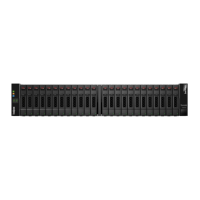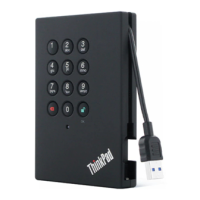# vim /etc/sysconfig/network-scripts/ifcfg-<NIC port>Edit: BOOTPROTO=none
ONBOOT=yes
NM_CONTROLLED=no
Add: IPADDR=192.168.xxx.xxx
NETMASK=255.255.255.0
Note: Be sure to set the address for both iSCSI initiator ports.
c. Restart network services.
# systemctl restart network
d. Make sure the Linux server can ping all of the iSCSI target ports.
Step 6. Configure the iSCSI interfaces by creating two iSCSI iface bindings.
iscsiadm –m iface –I iface0 –o new
iscsiadm –m iface –I iface0 –o update –n iface.net_ifacename –v <NIC port1>
iscsiadm –m iface –I iface1 –o new
iscsiadm –m iface –I iface1 –o update –n iface.net_ifacename –v <NIC port2>
Note: To list the interfaces, use iissccssiiaaddmm ––mm iiffaaccee.
Step 7. Establish the iSCSI sessions between initiators and targets (four total).
a. Discover iSCSI targets. Save the IQN (it will be the same with each discovery) in the worksheet
for the next step.
iscsiadm –m discovery –t sendtargets –p 192.168.0.1:3260 –I iface0 –P 1
Note: The IQN looks like the following:
iqn.2002-09.lenovo:de-series.600a098000af40fe000000005b565ef8
b. Create the connection between the iSCSI initiators and iSCSI targets, using ifaces.
iscsiadm –m node –T iqn.2002-09.lenovo:de-series.600a098000af40fe000000005b565ef8
–p 192.168.0.1:3260 –I iface0 -l
c. List the iSCSI sessions established on the host.
# iscsiadm -m session
Verify IP network connections
You verify Internet Protocol (IP) network connections by using ping tests to ensure the host and array are
able to communicate.
Step 1. On the host, run one of the following commands, depending on whether jumbo frames are enabled:
If jumbo frames are not enabled, run this command:
ping -I <hostIP> <targetIP>
If jumbo frames are enabled, run the ppiinngg command with a payload size of 8,972 bytes. The IP and
ICMP combined headers are 28 bytes, which when added to the payload, equals 9,000 bytes. The
-s switch sets the packet size bit. The -d switch sets the debug option. These options allow jumbo
frames of 9,000 bytes to be successfully transmitted between the iSCSI initiator and the target.
ping -I <hostIP> -s 8972 -d <targetIP>
In this example, the iSCSI target IP address is 192.0.2.8.
#ping -I 192.0.2.100 -s 8972 -d 192.0.2.8
Pinging 192.0.2.8 with 8972 bytes of data:
Reply from 192.0.2.8: bytes=8972 time=2ms TTL=64
Reply from 192.0.2.8: bytes=8972 time=2ms TTL=64
Reply from 192.0.2.8: bytes=8972 time=2ms TTL=64
Reply from 192.0.2.8: bytes=8972 time=2ms TTL=64
Ping statistics for 192.0.2.8:
86 ThinkSystem DE Series Hardware Installation and Maintenance Guide for 2U Enclosures

